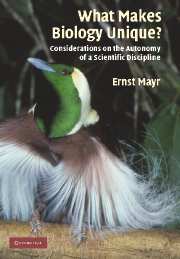Book contents
- Frontmatter
- Contents
- Preface
- Acknowledgments
- Introduction
- 1 Science and sciences
- 2 The autonomy of biology
- 3 Teleology
- 4 Analysis or reductionism?
- 5 Darwin's influence on modern thought
- 6 Darwin's five theories of evolution
- 7 Maturation of Darwinism
- 8 Selection
- 9 Do Thomas Kuhn's scientific revolutions take place?
- 10 Another look at the species problem
- 11 The origin of humans
- 12 Are we alone in this vast universe?
- Glossary
- Index
- References
10 - Another look at the species problem
Published online by Cambridge University Press: 10 December 2009
- Frontmatter
- Contents
- Preface
- Acknowledgments
- Introduction
- 1 Science and sciences
- 2 The autonomy of biology
- 3 Teleology
- 4 Analysis or reductionism?
- 5 Darwin's influence on modern thought
- 6 Darwin's five theories of evolution
- 7 Maturation of Darwinism
- 8 Selection
- 9 Do Thomas Kuhn's scientific revolutions take place?
- 10 Another look at the species problem
- 11 The origin of humans
- 12 Are we alone in this vast universe?
- Glossary
- Index
- References
Summary
The species, together with the gene, the cell, the individual, and the local population, are the most important units in biology. Most research in evolutionary biology, ecology, behavioral biology, and almost any other branch of biology deals with species. How can one reach meaningful conclusions in this research if one does not know what a species is and, worse, when different authors talk about different phenomena but use for them the same word – species? But this, it seems, is happening all the time, and this is what is referred to as the species problem. There is perhaps no other problem in biology on which there is as much dissension as the species problem. Every year several papers, and even entire volumes, are published, attempting to deal with this problem.
The species is indeed a fascinating challenge. In spite of the maturation of Darwinism, we are still far from having reached unanimity on the origin of new species, on their biological meaning, and on the delimitation of species taxa. The extent of the remaining confusion is glaringly illuminated by a recent book on the phylogenetic species concept (Wheeler and Meier 2000). From the discussions of some of the participating authors, it is quite evident that they are unaware of much of the recent literature. The result is great confusion. This induced me, contrary to earlier intentions, to write here once more about the species problem, even though I discussed the subject only quite recently (Mayr 1987, 1988, 1996, 2000).
- Type
- Chapter
- Information
- What Makes Biology Unique?Considerations on the Autonomy of a Scientific Discipline, pp. 171 - 194Publisher: Cambridge University PressPrint publication year: 2004



